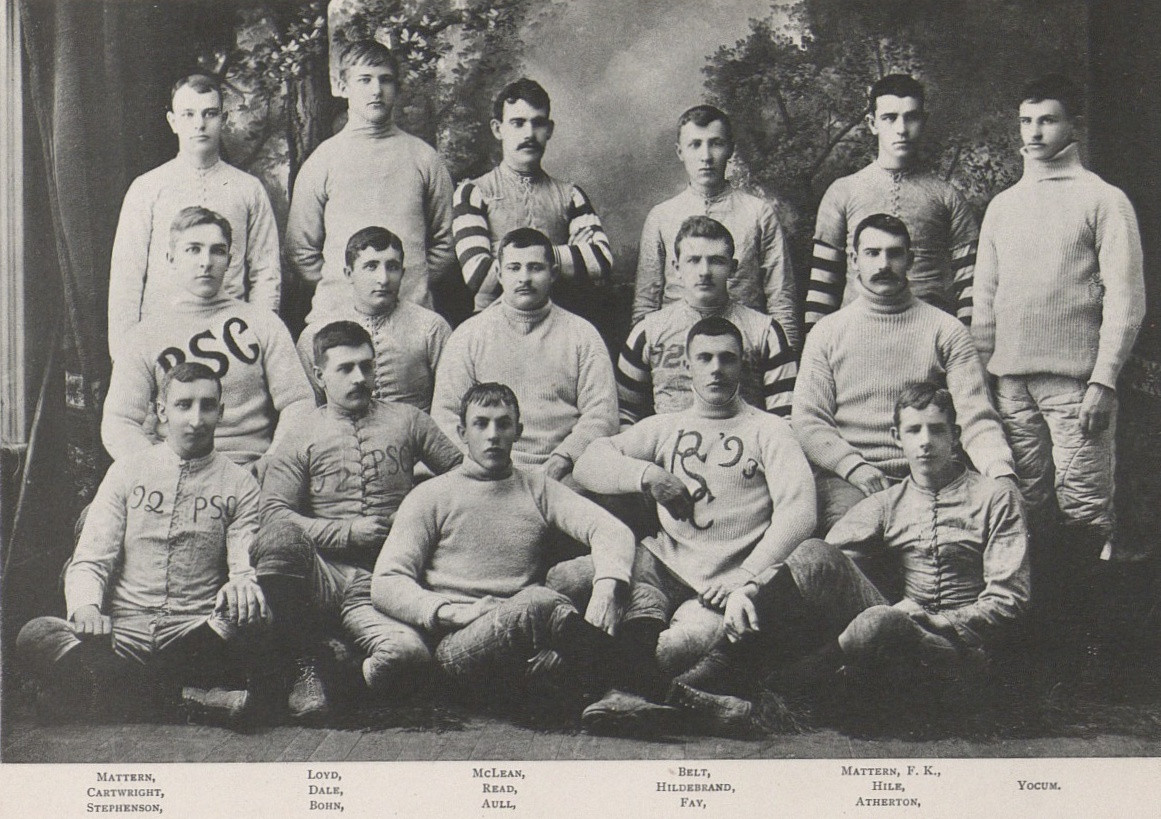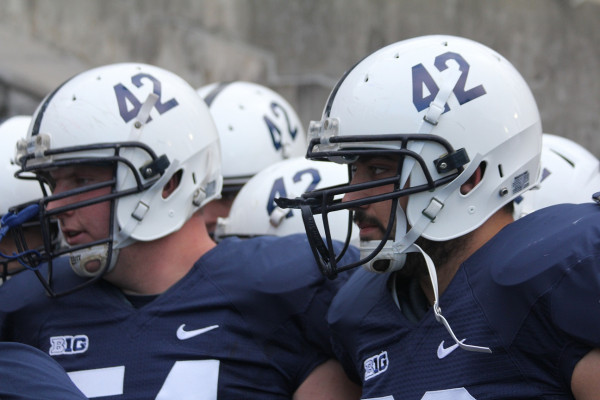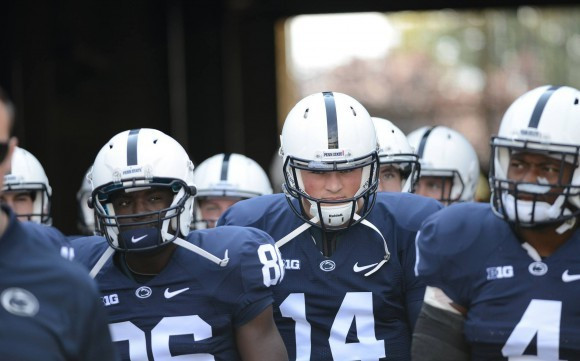As Homecoming approaches, Penn State Nittany Lions fans eagerly anticipate the “Generations Of Greatness” throwback uniforms for the game against Illinois. While renowned for their timeless simplicity, the Penn State Football Uniform has undergone a fascinating transformation since the program’s inception in 1887. Let’s delve into the annals of history to explore the captivating journey of these iconic threads.
1887: The Pink and Black Era
In 1887, Penn State embraced college football, marking the dawn of Nittany Lions football on Old Main Lawn against Bucknell. College football was in its nascent stages, lacking widespread organization or standardization. Players were responsible for providing their own gear, leading to a chaotic mix of colors and styles on the field. Eyewitness accounts detail instances of Penn State players inadvertently passing the ball to opponents due to uniform confusion.
To address this, the team decided to adopt matching colors. Initially, Penn State chose pink and black, reflecting the university’s original, albeit short-lived, school colors.
The 1887 Penn State football team sporting the original pink and black uniforms, a reflection of early collegiate sports attire.
1890: The Birth of Blue and White
After three seasons and nine games, the pink and black uniforms faced an unexpected challenge: wear and tear. Washing caused the pink to fade to white, while sunlight transformed the black into navy blue. Recognizing this unintended evolution, the student athletic association formally adopted blue and white as the team’s colors in 1890. This decision was soon ratified by the entire student body, solidifying blue and white as Penn State’s enduring and iconic colors.
 1890 Penn State football team – Wikipedia
1890 Penn State football team – Wikipedia
1930: Numbers Enter the Game
The 1930s brought a practical addition to the Penn State uniform: player numbers. To improve player identification on the field, numbers were added to both the front and back of the jerseys. This innovation aided spectators and coaches alike in distinguishing players during the game’s action.
 A vintage photograph from 1930 capturing Penn State in action against Iowa, highlighting the introduction of jersey numbers for player visibility.
A vintage photograph from 1930 capturing Penn State in action against Iowa, highlighting the introduction of jersey numbers for player visibility.
1954: Stripes Make Their Debut
Under the guidance of head coach Rip Engle, the 1954 season witnessed the introduction of stripes to the Penn State uniform. Stripes were added down the sides of the pants and around the arm sleeves, a design reminiscent of the “Generations of Greatness” throwback uniforms that would later debut in 2017. This marked the first significant stylistic embellishment to the otherwise minimalist uniform. The design evolved in subsequent years, transitioning to a single stripe on the jersey sleeves in the late 1950s, while the pant stripes were removed by the mid-1960s. Interestingly, the sleeve stripe was briefly discontinued in 1966 but made a comeback in 1980.
 Lenny Moore, a standout tailback and wide receiver, pictured in 1954 wearing the striped Penn State uniform introduced by Coach Rip Engle.
Lenny Moore, a standout tailback and wide receiver, pictured in 1954 wearing the striped Penn State uniform introduced by Coach Rip Engle.
1968: Helmet Numbers – A Paterno Era Innovation
The arrival of legendary head coach Joe Paterno in 1966 ushered in an era of unprecedented success and enduring traditions. In 1968, Paterno made a distinctive mark on the Penn State uniform by adding player numbers to the helmets. Although briefly tested in 1961, helmet numbers became a permanent fixture in 1968, further aiding player identification and adding a unique visual element. However, this feature was removed again in 1974, showcasing the dynamic nature of uniform design even within established programs.
 Countdown to Kickoff: 68 days until Penn State football
Countdown to Kickoff: 68 days until Penn State football
1980-2010: Decades of Subtle Refinement
Following the uniform adjustments of the 1970s, the Penn State uniform entered a period of relative stability for nearly three decades. Minor modifications were implemented, including changing the helmet facemask color from gray to navy blue in 1987. A significant partnership began in 1993 when Penn State signed a three-year deal with Nike worth $2.3 million. This collaboration introduced the iconic Nike “swoosh” to the uniform, initially placed on the sleeves in 1993 and then relocated to the upper left chest in 1994, becoming a subtle yet recognizable brand element.
Former running back Ki-Jana Carter pictured during a 1993 game against Michigan, showcasing the introduction of the Nike swoosh on the sleeve after the Penn State-Nike partnership.
2011: A Streamlined Look
The 2011 season marked a departure from the longer-standing design elements as Penn State opted to remove the stripes from the sleeves and collars of the jerseys. This alteration represented the most noticeable change to the uniform’s aesthetic since 1980, signaling a move towards an even cleaner and more minimalist design.
2012: Honoring Tradition and Players
The year 2012 brought significant changes both on and off the field for Penn State football. Bill O’Brien’s appointment as head coach led to a unique and symbolic addition to the uniform: players’ last names were added to the back of their jerseys. This unprecedented move was intended to honor the players who remained committed to the program amidst NCAA sanctions related to the Sandusky scandal. The Big Ten logo was also added to the front of the jerseys, signifying Penn State’s conference affiliation. Furthermore, an emotionally charged Senior Day saw players wear No. 42 decals on their helmets to honor injured captain Michael Mauti, marking the return of numbers to Penn State helmets for the first time since 1974, albeit temporarily.
 A 2012 Penn State jersey featuring the player’s last name on the back, a unique element introduced by Coach Bill O’Brien to recognize player commitment.
A 2012 Penn State jersey featuring the player’s last name on the back, a unique element introduced by Coach Bill O’Brien to recognize player commitment.
 Penn State Helmet
Penn State Helmet
2013: Athletics Branding
In 2013, another subtle branding element was incorporated into the uniform with the addition of the Penn State Athletics logo to the center of the jersey collar. This detail further integrated the university’s athletic identity into the team’s apparel.
 A Penn State player in 2013 showcasing the Penn State Athletics logo placed at the center of the jersey collar.
A Penn State player in 2013 showcasing the Penn State Athletics logo placed at the center of the jersey collar.
2015: Return to Classic Simplicity
Under head coach James Franklin, the Penn State uniform underwent its most recent significant alteration in 2015. The players’ last names were removed from the jerseys, reverting to the classic, name-less design that had become synonymous with Penn State football for decades. This change solidified the current iteration of the Penn State uniform, emphasizing its timeless and understated aesthetic.
 The Penn State football uniform as seen from 2015 onwards, representing a return to the classic, name-less jersey design.
The Penn State football uniform as seen from 2015 onwards, representing a return to the classic, name-less jersey design.
Conclusion: Tradition Endures
From its humble beginnings with mismatched gear and pink and black colors to the iconic blue and white we know today, the Penn State football uniform’s journey reflects the program’s rich history and enduring traditions. While subtle changes and modern branding elements have been incorporated over time, the core essence of the uniform remains: a symbol of Penn State pride, tradition, and the unwavering spirit of the Nittany Lions. The upcoming “Generations of Greatness” throwback game is a fitting tribute to this storied uniform legacy.
